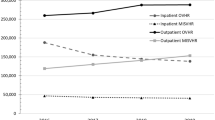Abstract
Background
Access to care and barriers to achieving health equity remain persistent and prevailing issues in the USA, particularly for low socioeconomic (L-SES) populations. Previous studies have shown that public insurance (a surrogate marker for L-SES) is an independent predictor of emergent hernia repair. However, the impact of insurance type on postoperative healthcare utilization, including emergency department (ED) care, following ventral hernia repair (VHR) remains unknown.
Methods
The 2013–2020 Abdominal Core Health Quality Collaborative (ACHQC) database was used to identify patients aged 18–64 undergoing ventral hernia repair (VHR) who had private or Medicaid insurance. Patients with no health insurance were also included. Using insurance type, the cohort was divided into three groups: private, public (Medicaid), and uninsured (self-pay). Multivariate logistic regression analyses were used to assess the impact of insurance type on emergency department (ED) utilization, postoperative complications, and readmission.
Results
A total of 17,036 patients undergoing VHR were included in the study, out of which 13,980 (85.8%) had private insurance, 2,451 (8.4%) had public, and 605 (5.8%) were uninsured. Following adjustment for demographics (age, gender, race), comorbidities (hypertension, diabetes, smoking), and clinical characteristics (emergent procedure, ASA class, surgical approach), public insurance was associated with 1.7 times greater odds of returning to the emergency department (ED) within 30 days of surgery compared to private insurance (95% CI 1.4, 2.0; p = 0.01). Public insurance or being uninsured was also associated with increased odds of experiencing any postoperative complications compared to those who were privately insured (public: OR 1.3, p < 0.01; self-pay: OR 1.67, p < 0.01).
Conclusion
Our study demonstrates that public and self-pay insurance are associated with increased emergency department (ED) utilization and worse postoperative outcomes compared to those with private insurance. In an effort to promote health equity, healthcare providers need to assess how parameters beyond physical presentation may impact a patient’s health.
Similar content being viewed by others
References
Brown EE, Schwartz M, Shi C et al (2020) Understanding why urban, low-income patients miss primary care appointments: insights from qualitative interviews of West Philadelphians. J Ambulatory Care Manage. 43(1):30–40. https://doi.org/10.1097/JAC.0000000000000316
Nabi J, Tully KH, Cole AP et al (2021) Access denied: the relationship between patient insurance status and access to high-volume hospitals. Cancer. 127(4):577–585. https://doi.org/10.1002/cncr.33237
Halpern MT, Ward EM, Pavluck AL, Schrag NM, Bian J, Chen AY (2008) Association of insurance status and ethnicity with cancer stage at diagnosis for 12 cancer sites: a retrospective analysis. Lancet Oncol. 9(3):222–231. https://doi.org/10.1016/S1470-2045(08)70032-9
Allen H, Gordon SH, Lee D, Bhanja A, Sommers BD (2021) Comparison of utilization, costs, and quality of Medicaid vs Subsidized private health insurance for low-income adults. JAMA Netw Open. 4(1):e2032669. https://doi.org/10.1001/jamanetworkopen.2020.32669
Wolf LL, Scott JW, Zogg CK et al (2016) Predictors of emergency ventral hernia repair: targets to improve patient access and guide patient selection for elective repair. Surgery. 160(5):1379–1391. https://doi.org/10.1016/j.surg.2016.06.027
Wang DE, Chung PJ, Barrera R, Coppa GF, Alfonso AE, Sugiyama G (2021) Systemic determinants in surgery: nonclinical factors affecting time to operation for incarcerated ventral hernias. Am Surg. https://doi.org/10.1177/00031348211011118
Simon KL, Frelich MJ, Gould JC, Zhao HS, Szabo A, Goldblatt MI (2015) Inpatient outcomes after elective versus nonelective ventral hernia repair. J Surg Res. 198(2):305–310. https://doi.org/10.1016/j.jss.2015.03.073
London JA, Utter GH, Sena MJ, Chen SL, Romano PS (2009) Lack of insurance is associated with increased risk for hernia complications. Ann Surg. 250(2):331–337. https://doi.org/10.1097/SLA.0b013e3181ae9d27
Novitsky YW, Orenstein SB (2013) Effect of patient and hospital characteristics on outcomes of elective ventral hernia repair in the United States. Hernia J Hernias Abdom Wall Surg. 17(5):639–645. https://doi.org/10.1007/s10029-013-1088-5
Singh S, Zagadailov P, Turner AL, Merchant AM (2021) Socioeconomic risk factors for mortality and readmission after surgery for bowel obstruction: an analysis of the Nationwide Readmissions Database. Am J Surg. https://doi.org/10.1016/j.amjsurg.2021.04.026
Shaw JH, Wesemann LD, Ayoola AS, Les CM, Charters MA, North WT (2021) Comparison of area deprivation index, socioeconomic parameters, and preoperative demographics with postoperative emergency department visits after total knee arthroplasty. J Arthroplasty. 36(8):2788–2794. https://doi.org/10.1016/j.arth.2021.03.058
Hwang U, Dresden SM, Vargas-Torres C et al (2021) Association of a geriatric emergency department innovation program with cost outcomes among Medicare beneficiaries. JAMA Netw Open. 4(3):e2037334. https://doi.org/10.1001/jamanetworkopen.2020.37334
Grudzen C, Richardson LD, Baumlin KM et al (2015) Redesigned geriatric emergency care may have helped reduce admissions of older adults to intensive care units. Health Aff (Millwood). 34(5):788–795. https://doi.org/10.1377/hlthaff.2014.0790
Berkowitz SA, Parashuram S, Rowan K et al (2018) Association of a care coordination model with health care costs and utilization: the Johns Hopkins community health partnership (J-CHiP). JAMA Netw Open. 1(7):e184273. https://doi.org/10.1001/jamanetworkopen.2018.4273
Burton RA, Zuckerman S, Haber SG, Keyes V (2020) Patient-centered medical home activities associated with low Medicare spending and utilization. Ann Fam Med. 18(6):503–510. https://doi.org/10.1370/afm.2589
Author information
Authors and Affiliations
Corresponding author
Ethics declarations
Disclosures
Savannah Renshaw, Dahlia Kenawy, Rosevine Azap, Anand Gupta, and Courtney Collins have no conflicts of interest or financial ties to disclose. Benjamin Poulose has received research support from BD and Advanced Medical Solutions. He currently receives salary support from the Abdominal Core Health Quality Collaborative (ACHQC) as the Director for Quality and Outcomes.
Additional information
Publisher's Note
Springer Nature remains neutral with regard to jurisdictional claims in published maps and institutional affiliations.
Rights and permissions
About this article
Cite this article
Renshaw, S., Kenawy, D., Azap, R. et al. Impact of insurance type in postoperative emergency department utilization and clinical outcomes following ventral hernia repair (VHR). Surg Endosc 36, 9416–9423 (2022). https://doi.org/10.1007/s00464-022-09287-7
Received:
Accepted:
Published:
Issue Date:
DOI: https://doi.org/10.1007/s00464-022-09287-7




